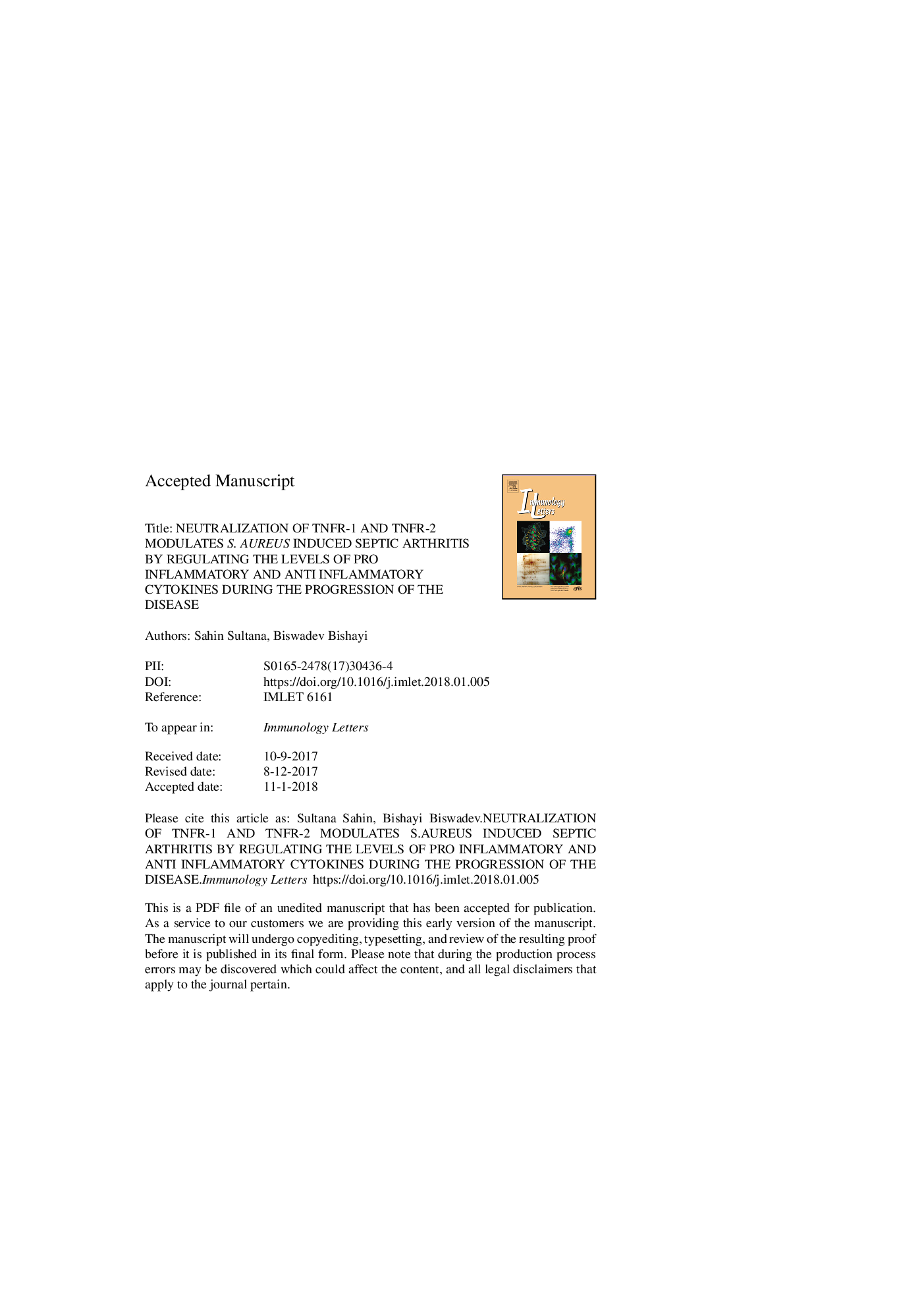| Article ID | Journal | Published Year | Pages | File Type |
|---|---|---|---|---|
| 8738323 | Immunology Letters | 2018 | 54 Pages |
Abstract
Staphylococcal septic arthritis remains a serious medical concern due to rapid and sustained production of inflammatory cytokines that leads to progressive and irreversible joint destruction with high mortality rate in patients despite adequate antibiotics treatment. TNF-α signalling via TNFR-1 contributes to arthritic destruction by aggravating inflammation. Impact of TNFR-2 signalling is not well established in this aspect. Hence the objective of our study was to evaluate the role of dual neutralization TNFR-1 and TNFR-2 in the pathogenesis of S. aureus infection induced septic arthritis. Mice were infected with live S. aureus (5â¯Ãâ¯106â¯cells/ml) followed by administration of TNFR-1and TNFR-2 neutralizing antibody. To measure arthritis index and osteoclastogenesis, histology result in joint tissue and TRAP staining images of arthritis joints have been performed respectively. Maximum reduction in the joint and paw swelling was observed in infected mice treated with both TNFR-1 and TNFR-2 antibody. NF-κB signalling was found to be mainly regulated by TNFR-1 whereas TNFR-2 significantly modulated JNK pathway. Lowest levels of inflammatory cytokines like TNF-α, IL-1β, IL-6, and IFN-γ were observed in both serum and synovial tissues signifying maximum protection in S. aureus arthritis during combination treatment. However IFN-γ and IL-10 levels were significantly altered by TNFR-2 neutralization that indicates both pro and anti inflammatory role of TNFR-2 respectively. Highest decrement in ROS concentration, iNOS expression with least MPO and lysozyme activity was detected in case of combined neutralization. During the early phase of infection all the aforesaid inflammatory parameters remained elevated due to lack of IL-10 as a result of TNFR-2 neutralization as IL-10 negatively modulates pro inflammatory cytokines. Increase in inflammatory cytokines during early phase might also be responsible for decreased bacterial count in TNFR-2 neutralized groups. Thus it can be suggested that combined administration of TNFR-1 and TNFR-2 antibody has a beneficial effect against the severity of S. aureus induced arthritis.
Keywords
c-Jun N terminal kinaseTBSTCyt CIFN-γIL-10IL-1βHBSSPMNiNOSRANKLHRPNADPHPVDFCPCSEAIAECJnkPBSDPINF-κBRoswell Park Memorial Institute-1640RPMI-1640CFUIL-6PGNMPODMSOH2O O2−ROSTLRscollagen-induced arthritisenzyme linked immunosorbant assayEDTAethylene diamine tetraacetic acidStaphylococcus aureusS. aureussodium dodecyl sulphate–polyacrylamide gel electrophoresisSDS-PAGEInterleukin-10interleukin-6interleukin-1betaRIPA bufferanalysis of varianceANOVAELISAtumor necrosis factor- alphaintraperitonealpolyvinylidene difluorideDimethyl sulfoxidedays post infectioninducible nitric oxide synthaseCIAcytochrome cTNF-αnuclear factor kappa BPhosphate buffered salineLuria–BertaniToll like receptorsHank’s balanced salt solutionmyeloperoxidasePolymorphonuclear neutrophilsNitric oxidenicotinamide adenine dinucleotide phosphatePeptidoglycancolony forming unitInstitutional Animal Ethical CommitteeCommittee for the Purpose of Control and Supervision of Experiments on AnimalsInterferon gammaReactive oxygen speciesreceptor activator of nuclear factor kappa-B ligand
Related Topics
Life Sciences
Immunology and Microbiology
Immunology
Authors
Sahin Sultana, Biswadev Bishayi,
